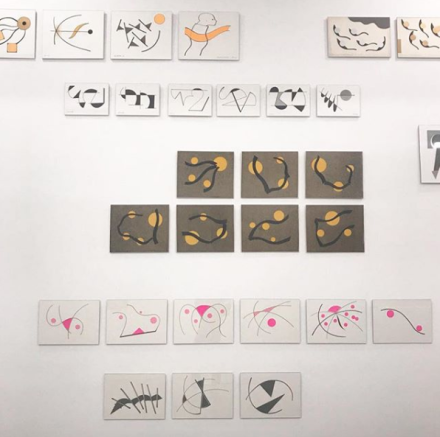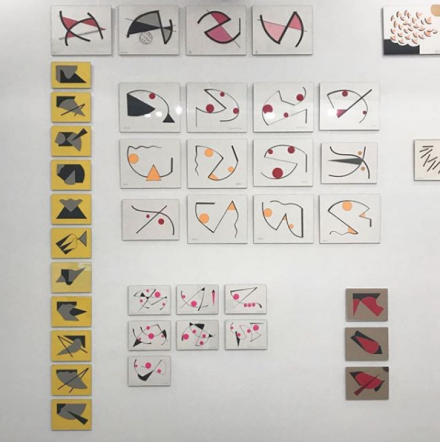
Geta Bratescu, The Leaps of Aesop (Installation View), via Art Observed.
This spring, the Romanian Pavilion at the Venice Biennale opened its exhibition for this year’s iteration of the institution’s ongoing exhibition. The show, a string of drawings and paintings creeping up the walls of the gallery, and running across each of the rooms formed dense networks of gestures and panels that made each of their respective movements and concepts all the more powerful. The show was a review of the career of Geta Bratescu, the 91-year old artist whose career has investigated the range of 20th Century practice as her own relationship to it grew and evolved over the course of her life. In the months running up to the opening of the exhibition, Bratescu joined on with Hauser & Wirth, and now brings a range of her works to bear on the gallery’s Chelsea exhibition space.

Geta Bratescu, The Leaps of Aesop (Installation View), via Art Observed
The show is a fitting survey of Bratescu’s work over the past decades, calling the iconographies and languages of her varied explorations into a lingering engagement with each other. Her cut paper works negotiate with stark self-portraits, while in other rooms her serial drawings mix with singular brushstrokes and imaginative abstractions. Representing her own feminist response to the power structures of the modern art world, and her personal, identity politics as a response to the various languages of conceptual and avant-garde practices in the half-century following WWII, Bratescu’s work inserts her image into repetitive, almost boundless encounters and discoveries of the languages of painting and drawing developing as she honed her own practice.

Geta Bratescu, The Leaps of Aesop (Installation View), via Art Observed.
Playful line drawings and images fall into line with the artist’s own created persona as “tragicomic in her Chaplinesque destiny,” a sense of both chaos and humor inherent in her own continued attempts to find the brighter sides of her existence during the oppressive post-war communist regime of Nicolae CeauÅŸescu. Paint and ink dance and snake across the canvas, often forming political caricatures, portraits and icons drawing on these subtle political and social threads. In other works, she mixes objects and photos, drawing together disparate historical and personal connections to create enigmatic compositions, spatial riddles that pull the viewer deeper into her own subjective engagement with the landscape of Romania.

Geta Bratescu, The Leaps of Aesop (Installation View), via Art Observed.
For Bratescu’s work, these momentary inflections of the real, of spirited inclusions of the often dark history of Romania over the course of her life, and her continued acts of response, of levity and critique and subversion, serve as both a reflection and comment on her perspective living in Eastern Europe in the years following the war. Her gestures and movements, energized with various autobiographical threads and snippets of backstory, make for a body of work that seems constantly involved in the world around her, while always looking hopefully towards a world just beyond the horizon.
The exhibition closes December 23rd.

Geta Bratescu, The Leaps of Aesop (Installation View), via Art Observed.
— A. Corrigan
Read more:
Geta Brătescu: The Leaps of Aesop [Exhibition Site]



